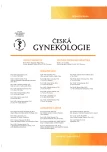Laparoscopic correction of isthmocele combined with ventrosuspensios of uterus
Authors:
K. Šubová 1; Martin Němec 1
; R. Pilka 2
Authors place of work:
Gynekologicko-porodnické oddělení Nemocnice, Frýdek-Místek, primář MUDr. M. Němec
1; Porodnicko-gynekologická klinika LF UP a FN, Olomouc, přednosta prof. MUDr. R. Pilka, Ph. D.
2
Published in the journal:
Ceska Gynekol 2020; 85(2): 104-110
Category:
Kazuistika
Summary
Objective: To describe a case history of a patient after two caesarean sections, planning another pregnancy. Due to the dehiscent lower uterine segment, surgical correction of the defect was performed. Performance followed by an unplanned pregnancy five weeks after the operation.
Design: Case report.
Setting: Department of Obstetrics and Gynaecology, Hospital in Frýdek-Místek.
Case report: We present a case of a 31-year-old third-graders, anamnestically after two caesarean sections, which were performed laparoscopical correction of isthmocoele in our department. Our patient was diagnosed with six weeks old intrauterine pregnancy only eleven weeks after surgery. The gravidity was successfully completed in the 38th week of pregnancy by the planned caesarean section with finding of a solid lower uterine segment. Whole duration of the pregnancy was uncomplicated.
Conclusion: Women, after previous surgery of the uterus, are exposed to complications such as nidation disorders, placental disorders, risk of uterine rupture etc. during future pregnancy and childbirth. We want to show possible advantage of laparoscopic isthmocoele resection in combination with ventrosuspension of uterus.
Keywords:
isthmocoele – laparoscopy – caesarean section – uterine rupure
Zdroje
1. Andonovová, V., Hruban L., Gerychová L., et al. Rupura dělohy v těhotenství a při porodu: rizikové faktory, příznaky a perinatální výsledky – retrospektivní analýza. Čes Gynek, 2019, 84(2), s. 121–126.
2. Bij de Vaate, AJ., Van der Voet, LF., Naji, O., et al. Prevalence, potential risk factors for development and symptoms related to the presence of uterine niches following cesarean section: systematic review. Ultrasound Obstet Gynecol, 2014, 43(4), p. 372–382.
3. Donnez, O., Donnez, J., Orellana, R., et al. Gynecological and obstetrical outcomes after laparoscopic repair of a cesarean scar defect in a series of 38 women. Fertil Steril, 2017, 107(1), p. 289–296.e2.
4. Hayakawa, H., Itakura, A., Mitsui, T., et al. Methods for myometrium closure and other factors impacting effects on cesarean section scars of the uterine segment detected by the ultrasonography. Acta Obstet Gynecol Scand, 2006, 85, p. 429–434.
5. https://www.mzcr.cz/dokumenty/v%C2%A0roce-2018-klesl-pocet-predcasnych-porodu-a-cisarskych-rezuukazala-data-ze-vs_17429_1.html
6. Huirne, JAF., Vervoort, AJMW, Leeuw, R. De. Technical aspects of the laparoscopic niche resection, a step-by-step tutorial. Eur J Obstet Gynecol Reprod Biol, 2017, 219, p. 106–112.
7. Jeremy, B., Bonneau, C., Guillo, E., et al. Uterine ishtmique transmural hernia: results of its repair on symptoms and fertility. Gynecol Obstet Fertil, 2013, 41, p. 588–596.
8. Klimánková, V., Pilka, R. Pozdní morbidita u syndromu jizvy po císařském řezu. Čes Gynek, 2018, 83(4), s. 300–306.
9. Marotta, ML., Donnez, J., Squifflet, J., et al. Laparoscopic repair of post cesarean section uterine scar defects diagnosed in nonpregnant women. J Minim Invasive Gynecol, 2013, 20(3), p. 386–391.
10. Ofili-Yebovi, D., Ben-Nagi, J., Sawyer, E., et al. Deficient lower-segment cesarean section scars: prevalence and risk factors. Ultrasound Obstet Gynecol, 2008, 31(1), p. 72–77.
11. Resnik, R, Silver, RM. Clinical features and diagnosis of placenta accreta spectrum (placenta accreta, increta, and percreta). Dec 2019. https://www.uptodate.com/contents/clinical-features-and-diagnosis-of-placenta-accreta-spectrum-placenta-accreta-increta-and-percreta
12. Setubal, A., Alves, J., Osorio, F., et al. Treatment for uterine isthmocele, a pouchlike defect at the site of a cesarean section scar. J Minim Invasive Gynecol, 2018, 25(1), p. 38–46.
13. Tower, AM., Frishman, GN. Cesarean scar defects: an under-recognized cause of abnormal uterine bleeding and other gynecologic complications. J Minim Invasive Gynecol, 2013, 20, p. 562–572.
14. Tulandi, T., Cohen, A. Emerging manifestations of cesarean scar defect in reproductive-aged women. J Minim Invasive Gynecol, 2016, 23(6), p. 893–902.
15. Vandenberghe, G., De Blaere, M., Van Leeuw, V., et al. Nationwide population-based cohort study of uterine rupture in Belgium: results from the Belgian Obstetric Surveillance System. BMJ Open, 2016, 6:e010415. doi: 10.1136/bmjopen-2015-010415
16. Van der Voet, LF., Vervoort, AJ., Veersema, S., et al. Minimally invasive therapy for gynaecological symptoms related to a niche in the caesarean scar: a systematic review. BJOG, 2014, 121, p. 145–156.
17. Vervoort, AJ., Uittenbogaard, LB., Hehenkamp, WJ., et al. Why do niches develop in Caesarean uterine scars? Hypotheses on the aetiology of niche development. Hum Reprod, 2015, 30(12), p. 2695–2702.
Štítky
Detská gynekológia Gynekológia a pôrodníctvo Reprodukčná medicínaČlánok vyšiel v časopise
Česká gynekologie

2020 Číslo 2
- Ne každé mimoděložní těhotenství musí končit salpingektomií
- Mýty a fakta ohledně doporučení v těhotenství
- Je „freeze-all“ pro všechny? Odborníci na fertilitu diskutovali na virtuálním summitu
- I „pouhé“ doporučení znamená velkou pomoc. Nasměrujte své pacienty pod křídla Dobrých andělů
Najčítanejšie v tomto čísle
- Je nález hyperplazie či polypu děložní dutiny automatickou indikací k biopsii?
- Moderní terminologie a klasifikace sestupu pánevních orgánů ženy
- Laparoskopická korekce istmokély v kombinaci s ventrosuspenzí dělohy
- Diabetes typu MODY a screening gestačního diabetu
